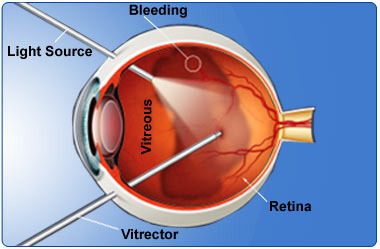A vitrectomy is a surgical procedure that removes the vitreous from the central cavity of the eye in certain disease conditions including diabetic eye disease (diabetic retinopathy), retinal detachments, macular holes, macular pucker and vitreous hemorrhage.
It is performed by a retinal surgeon using specially designed instruments and techniques. This is a day care procedure usually performed under local anesthesia. Generally, a vitrectomy takes about two hours, sometimes longer for more complex cases. But now, Vitrectomy can now be done using a 23 gauge trocar – cannula system (microincision surgery), which makes the procedure sutureless and faster.
The procedure involves removing the vitreous gel through a very small incision in the wall of the eye, which then gets replaced with a similar solution. Then, using a high intensity fiber optic light source, our retinal surgeon will use a specially designed optical microscope that allows for a clear view of the vitreous cavity and retina at different magnifications. Most often, the incisions are made through the pars plana part of the eye to avoid damage to the retina.

In order to achieve most favorable results, the retinal surgeon may use several special techniques, including:
Intraocular gases
These gases are used to flatten a detached retina against the wall of the eye, in order to keep it attached or “in place” as healing occurs. Gases are also used to close macular holes. Until about 50% of the gas put into the eye is absorbed, vision post procedure remains poor. In such cases, patients are instructed to avoid high altitudes and flying as long as the gas is still in the eye(s). Also, patients are advised to keep their head in a certain position for a certain period of time to ensure the success of the treatment.
Silicone oil
In some cases, silicone oils are used instead of intraocular gases. The silicone oil stays in the eye for a much longer period of time, hence situations requiring the retina to be ‘flattened’ for a longer period, use silicone oil as replacement of the vitreous gel removed during the surgery. This oil is later surgically removed. Vision is not affected by the silicone oil and positioning is less vital, making this procedure more favourable for children.
Scleral buckling
This is a technique often combined with a vitrectomy procedure to offer additional support in reattaching the retina. It is done by treating the retinal breaks with the cryoprobe. The breaks are supported with a piece of silicone sponge or solid sponge, called a scleral buckle. The buckle is specifically sewn onto the eyeball to apply pressure on the retinal break in order to effectively close it and prevent further leakage of vitreous fluid. The fluid under the retina will resorb within a couple of days. In some instances, we may choose to drain the fluid during surgery. This same day surgery can normally be performed using local anesthesia, and allows most patients to resume most daily activities within several days.
Lensectomy
It involves surgically removing the eye’s crystalline (natural) lens during the vitrectomy procedure. In some instances, this step may be necessary to gain access during more complex retinal detachment surgeries. The lens is replaced with a clear lens implant either during the same surgical procedure or at a later date.
For more information or to book appointment for Vitrectomy Treatment in Prayagraj, please contact Dr. Ashish Mitra at +91 8085309909 or write us at info@eyeclinicprayagraj.com
